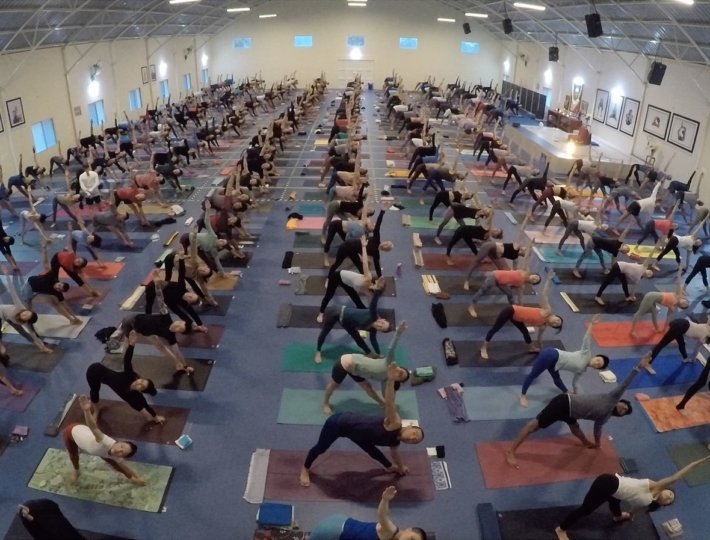The ultimate goal of yoga is to move toward a state of higher consciousness, but without good health and a strong, balanced system that’s free from disease, it is very difficult to find the necessary equanimity for this to happen. One of the main purposes of a daily āsana practice, therefore, is to function as therapy for the many different conditions and ailments that can affect physical, mental and emotional states. When practiced correctly, āsanas are able to heal and rectify imbalances and make the system strong, stable and resilient. As a result of curing disease and bringing oneself wholly into balance, we are then able to progress in yoga.
This concept was central to Pattabhi Jois’ teaching, which he explains in his book Yoga Mala: “Physical strength, mental strength, and the strength of the sense organs—all these are very important. Without them, one cannot attain spiritual strength…body and mind are inseparably linked, one to the other. If pleasure and pain are experienced by either the physical body or the sense organs, the mind will experience them as well…to learn how to achieve such concentration the body must first be purified and then mental strength developed. The method for purifying and strengthening the body is called āsana …” (pg 34, second English edition 2000, published by Eddie Stern / Patanjali Yoga Shala).
Jois called the Primary Series of Aṣṭāṅga yoga “roga cikitsā” meaning disease therapy and “cikitsā vibhāga” meaning therapy section. Although all Aṣṭāṅga yoga is generally therapeutic in nature, it is the Primary Series that specifically focuses on healing as a preparation for yoga sādhana. Indeed, it is therapy for everyone, even for those who are in good health since it not only cures, but also helps to maintain and revitalize the system at all levels.
What Exactly Is Cikitsā Vibhāga?
The title cikitsā vibhāga, given to the Primary Series, indicates that it’s main purpose is disease therapy, especially designed to repair, rejuvenate, and strengthen the system for the purpose of yoga. When analyzing the Primary Series in these terms, we can identify several different levels of therapeutic action. Firstly, the individual āsanas have specific benefits. Some work to treat or avert certain diseases, such as Jānuśīrṣāsanas A, B and C, which have curative and preventative effects in relation to diabetes. Some strengthen and repair specific organs or organ systems. For instance, the variations of paścimatānāsana increase the strength of the digestive fire, helping the system to digest food more efficiently and destroy the toxins that are taken into the body. Others work on alignment (such as Tiryaṅmukha ekapāda paścimatānāsana which helps to align the body and can be useful for treating sciatica) and purification (Marīcāsanas A, B, C and D have individual and overlapping effects related to purification of the gall bladder and large intestine as well as several other therapeutic actions.)
Within the series there is also a strong focus on realigning the musculoskeletal system and toning the muscles in the lower abdomen and pelvic floor, which are, incidentally, very important for establishing the correct breathing technique. Other postures from the Primary Series have benefits for the reproductive organs, kidneys, esophagus, heart, lungs and conditions, such as asthma to name a few. Pattabhi Jois has outlined the benefits of all the āsanas of the Primary Series in Yoga Māla as well as the benefits of the Sūryanamaskāras, standing poses, and finishing poses—common to all Aṣṭāṅga series.
The second level of action is the order and grouping of āsanas, which brings about a gradual transformation of the whole system. There is a sequential purification of the organ systems beginning with postures that strengthen the digestive system, which is the foundation for the health of the whole system. When the series is learned slowly, step-by-step in the appropriate order, each āsana prepares the practitioner for the next at both the physical and the metabolic level. Each āsana, or group of related āsanas, unlock the door to the next. The series should be learned gradually, one posture at a time, allowing the therapeutic process to unfold in a wholistic way.
Related: The Meditative Magic of Tristhāna in Ashtanga Yoga
Thirdly, the practice of the āsanas must be nurtured within the Aṣṭāṅga method of vinyāsa and tristhāna, which is important for all series of Aṣṭāṅga yoga. These essential elements are designed to increase blood flow to all organs and tissues, promote sweating to remove toxins, and support and calm the nervous system, resulting in a significant increase in the therapeutic effect of the individual āsanas. If any of the constituent parts of the method are eliminated from the practice, the same result will not be achieved. This method provides a process that works on the whole system and since the physical, mental, emotional and spiritual elements are intimately connected, there will be benefits felt in all these different areas. Once a state of equilibrium is found, daily practice maintains and enhances all these benefits. Practice of the Primary Series then becomes a daily tonic sustaining a healthy, well-balanced system.
Lastly, when the yamas and niyamas are practiced in conjunction with the āsana method, there is a greater mental clarity along with a purification and strengthening of the sense organs. This refers to a process in which the sense organs no longer lead us toward external pleasures, but rather draw us inward to experience yoga. This is when the process of yoga truly begins to flourish internally.
Āsana practice should not be an end in itself, but must prepare us for the higher limbs of yoga, first curing disease, strengthening, realigning, repairing, and rejuvenating the body and mind. Even when we feel that we are healthy, it is only after practicing Aṣṭāṅga yoga for some time that we will understand its transformative power and how much we have changed as a result of practice. It is through the curative effects of practice of cikitsā vibhāga that we can first experience the state of ananta, the combination of effortlessness and stability within āsana that is the condition for the meditative state of yoga to arise. And it is a strong and healthy body and mind forged through practice that is the vehicle for us to traverse the ocean of samsara so that we may experience yogic bliss.









Comments (0)